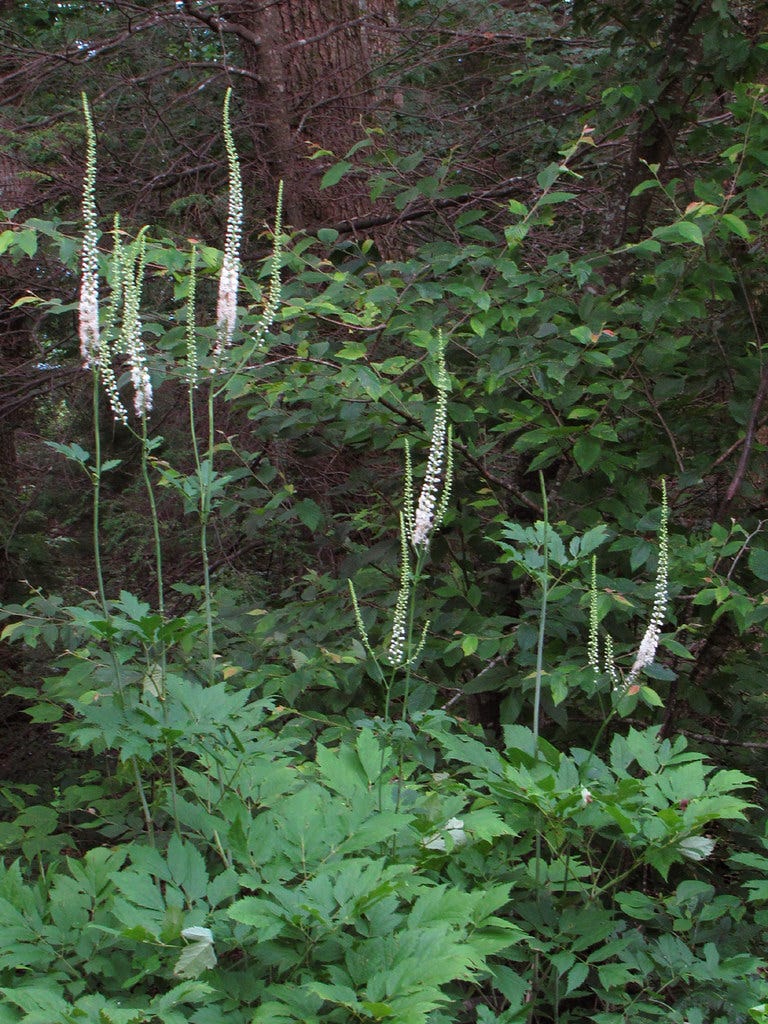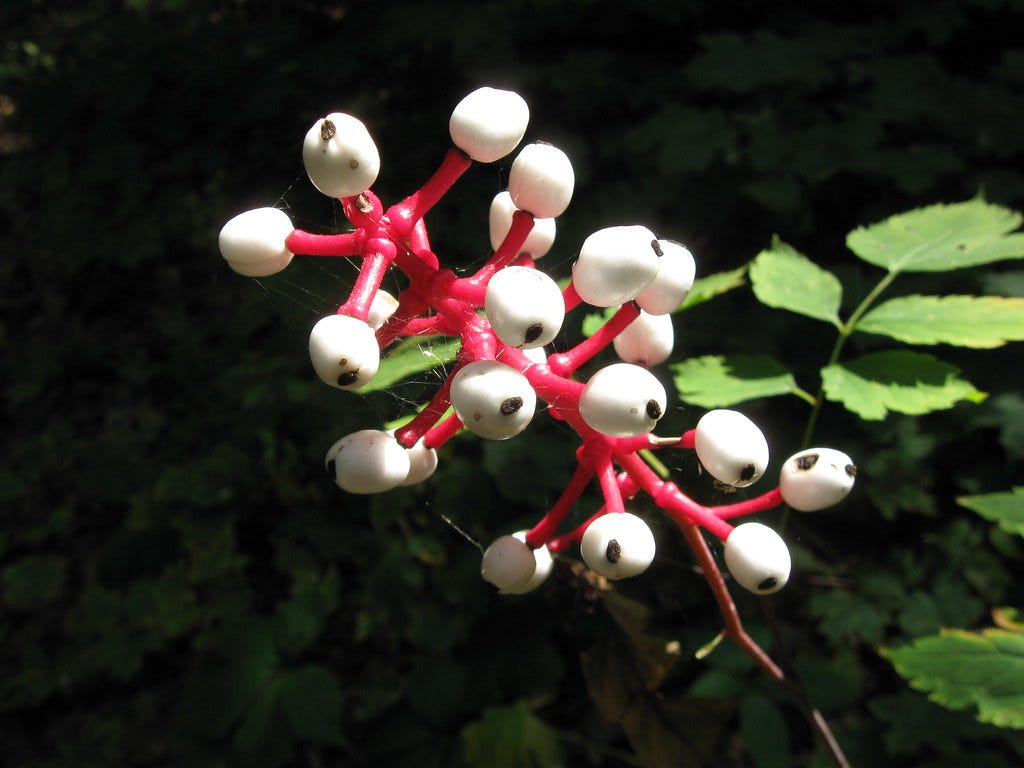ALSO KNOWN AS: Actaea racemosa, snake root, black bugbane, bugroot, fairy candles, rattleweed
How to know
Tall creamy racemes in groups of three
About 3-8 feet high
Toothy pinnate leaves at the base
Numbers can be an important kind of language for plants. Fibonacci dictated the swirl in composite plants. Flowers with five petals have been considered evil. “Three leaves, let them be” is a repeated phrase among people I talk to remembering the caution of poison ivy. When there is little else to distinguish a plant from another, numbers will separate the poison from the food. In the woods of the Appalachian mountains black cohosh counts quietly by three. In the spring black cohosh splits into three initial leaves, and then again into three stems. The leaves grow in pinnate formation of three: three leaves on a single stem. The stems of the black cohosh are nearly ghostly. Below a black or bluish tint, a white film covers the stem like a morning mist. It that can be rubbed off leaving a cool bluish base that is more pronounced at the nodes or plant joints. Black cohosh is such a beautiful vision in the forest you’ll wonder what died under it, or at least left a giant dump there. But it’s the flower that stinks. It calls the ants and flies to it with an absolutely dismal perfume.
Woodland Snakes
The racemes, or flower spikes, are magnificent as they rise like white boas in the forest. You can see a black cohosh plant from a distance because there are not many flowers that are so magnificent and shade-loving. For their dramatic flowers they have been alluded to candles, like sparks from fairies, leading wanderers deep into the dark forests. At the beginning of its blooming season the flowers begin with small green-to-white balls that open from the bottom up into white flowers that have no petals, just tiny bursts of stamens. The spires of buds stand straight until, at times, their weighty blooms sag.
The entire plant can grow up to eight feet tall but averages at about 4 feet. They have one, and rarely two sticky carpels, ready to adhere pollen. Each hides, nearly minuscule amid the cloud of stamens. The flowers are pollinated by flies and ants. Vibration from the bee wings will make the flowers shiver and release their white pollen into the midsummer air.
Opposing its name, black cohosh has white flowers. Its white pollen is common in many Asteraceae plants like daisies and sunflowers. The pollen of black cohosh may be a secret weakness to this otherwise formidable plant. A Clemson University study found that plants that have darker pollen have higher resilience under heat and stress. Plants in Western parts of the United States where there are more extreme heat events have adapted to darker pollen resulting in higher stress resilience, while the counterparts that are slightly lighter in the east have more resilience. From the richly pollenated flowers emerges a nearly invisible mist of pollen in early spring that hovers over the forest. All pollen itself comes from the anther of the plant. It is nearly microscopic and can have little hooks on the skin. But it always has a porous covering within which is a single cell with two male gametes. This tiny skin is so formidable that it has been found intact as fossils, again heralding the incredible strength of the plant.
But black cohosh is a threatened species, not only for its more delicate white pollen grains. Garlic mustard behaves aggressively in temperate forests and is crowding out the black cohosh to a nearly devastating effect in some states.
A poultice of black cohosh on the skin will detract mosquitos. One of its names, bug bane, alludes to its use as a bed bug repellent. But it has also adapted to summon flies looking for dead meat. So; flies of mosquitoes: choose your poison. In true buttercup fashion, the black cohosh doesn’t have fruit: they dry out. When the flowers die the follicles that hold the seeds will turn upward. As the season turns and the seeds mature the follicles will dry and when the wind blows it will shake these tall stems and they will drum like rattlesnake tails. Once the follicles dry to cracking the seeds will fall and germinate where they land.
This is a plant of height and narrowness like a stork. Its toothy leaves are splayed like partly open wings, at two feet in diameter. From these leafy wings the stem rises for feet into the air. The stalk emerges from the ground like the tiny claws of blue cohosh. They grow in medicinal rhizomes that can be cut and replanted. Each year the rhizome brings up a new shoot the plant will grow taller, averaging out to about 4’ in its full maturity. These roots are its namesake: cohosh is the Algonquin word for rough, to describe their rugged texture. And from these roots decoctions, steams, and elixirs could be prepared.
The Iroquois name for the plant translates to “horse smells”. Indeed its smell is not particularly acidic but subtle, almost animal and sweet, to our noses the scent comes on slowly. Black cohosh emits the smell of its food. It grows in the deep shade of the forest where humus builds easily and where soil is moist and well aerated. It would love for something to die or poop beside it because it soaks in the fetid underbelly of the forest, emitting a light from the dank with transcendent radiance.
An Ancient Medicine
Black cohosh is not related to the similarly named blue cohosh, but the two plants are both native to the woodlands of northeastern America from Ontario down to Georgia and from Massachusets to Arkansas with a concentration in North Carolina and West Virginia. They share similar leaf structures, a kind of leggy, close-to-the-ground claw shaped leaf. And, probably most importantly, these plants help people ovaries. They have been used during menstruation, birth, and menopause. White they look nothing like many of their family members, black cohosh is in the Ranunculus, or buttercup family and most closely related to baneberry.
This is the larval food of the spring azure butterfly, one of the first in flight in the season. These are tiny butterflies with light blue on the top of their wings with gray undersides.
In addition to treating menopausal conditions it has been used to treat malaria, sore throat, rheumatism, and musculoskeletal issues. Native American peoples throughout the region where this plant is native used it for a variety of medical purposes including rheumatism, sore throat, snake bites, and remedies for PMS, menopause, and birth. Scientifically, black cohosh has been proven to create an estrogen effect in the body, which is why it relieves the anxiety, hot flashes, and night sweats that can come with menopause. Around the 1950’s Germany put extracts from black cohosh on the market and ever since this has been a popular drug.
Even though black cohosh is sold for gardens and extracted for medicinal purposes there is no large scale cultivation of them. Most of them are sourced from wild plants.
People with ovaries can get into the habit of counting. We count days from our period, we count the days of our period. We notice how long it takes to bleed. People who are pregnant count months and days. Mothers count months, all to watch the change and cycles. Counting is a corporeal language.
Like all numbers, the black cohosh counts to a number larger than we can imagine. The amount of flowers, stamens, and carpels multiply, until, like all numbers, all we can do is represent it in an image: A flower rising like a flame in the deep forest.
myth for black cohosh
Not to be confused with blue cohosh that has single blue seeds. They share medicinal properties and they share a similarly shaped leaf structure. And while they have so many similarities, these two plants aren’t even in the same family!
Or doll’s eyes. These plants stay much closer to the ground and instead of forming follicles to hold the seeds, they create white berries with black dots, hence the name doll’s eyes: very creepy and very poisonous.
Forager Friendly?
In general, no. But don’t take my word for it. Research many sources before you make your decision about black cohosh. For one, black cohosh is threatened in some regions. And using this plant medicinally can have adverse effects with other herbs, foods, and medicines, similar to St. Johnswort.
Sources
https://www.youtube.com/watch?v=2uWR-RhflkE (amazing video that describes each part of the plant with clarity and detail)
https://ods.od.nih.gov/factsheets/BlackCohosh-HealthProfessional/
https://content.ces.ncsu.edu/black-cohosh-actaea-racemosa-l
https://www.srs.fs.usda.gov/pubs/gtr/gtr_srs097.pdf
https://www.amandasnativeplants.com/product-page/actaea-cimicifuga-racemosa-black-cohosh
https://mdc.mo.gov/discover-nature/field-guide/spring-azure
https://en.wikipedia.org/wiki/Actaea_(plant)
https://news.clemson.edu/clemson-scientist-explores-the-colorful-intricacies-of-pollen/
https://www.uaex.uada.edu/yard-garden/resource-library/plant-week/black-cohosh-7-15-05.aspx
https://www.uwa.edu.au/study/-/media/Faculties/Science/Docs/What-is-pollen.pdf








It’s supposed to be good for tinitus and hearing in general, a herbologist once told me